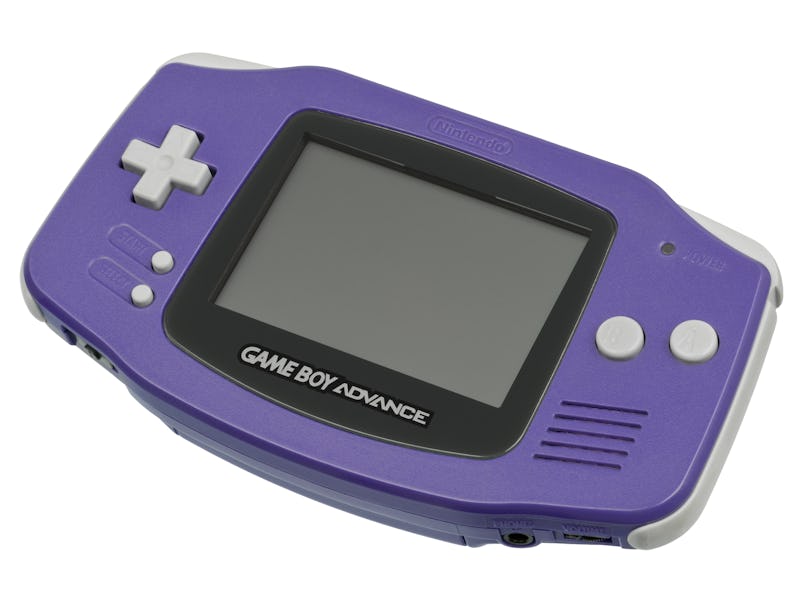22 Years Ago, Nintendo Changed Portable Game Consoles Forever
A purple game-changer.

On my sixth birthday, I got a Game Boy Pocket, which introduced me to some of my lifelong fascinations. I binged Pokémon, Mario, and Zelda games on the tiny black-and-white screen. But even then, it already felt outdated. Even at a young age, I knew there had to be a better way to play.
I would only have to wait three more years for my wish to be granted, with a fresh new Game Boy Advance in my greedy little hands. The bulky purple handheld brought me into a whole new dimension of color, graphics, and world-building that was previously impossible. I got to play reimagined classics like Super Mario Advance 2, team up with friends in The Legend of Zelda: Four Swords Adventures, and fight eco-terrorists in Pokémon Ruby. They were more than just games, but teaching and social tools that helped me to develop into the weirdo I am today.
And I was far from the only one. The Game Boy Advance has sold more than 81.5 million units since its release in March 2001, according to Nintendo. It’s the tenth-most successful console of all time, beating out the PSP and the 3DS. The GBA was the first portable that proved handheld games could have the same level of gameplay and polish as their console counterparts. Though the graphics weren’t three-dimensional, the games more than made up for it.
The purple Game Boy Advance is a childhood staple.
This small-but-mighty console had a rocky road to glory, evolving multiple times before it was sold overseas.
Murmurs of a successor to the original Game Boy started popping up in 1996 issues of video game magazines. Code-named “Project Atlantis,” it was said to have a 32-bit processor, a 3-by-2-inch screen, and a link port. Though the project was eventually canceled, we did get a glimpse of what it looked like. In 2009, Masato Kuwahara, project leader on the development of Nintendo DSi, showed off a few old Nintendo prototypes at a GDC talk, with many believing one slide labeled “Game Boy Advance predecessor” was actually that scrapped mid-’90s project.
This might be Project Atlantis
In 1999, Nintendo first started sharing news of the Advanced Game Boy (which was just a fancier version of a Game Boy Color) and a new 32-bit system at its Space World Tradeshow. In September of that year, it officially announced the Game Boy Advance, which would have a high-end CPU and be able to display over 65,000 colors. The Gameboy Pocket and Color were already clunky dinosaurs by the dawn of Y2K and if Nintendo wanted to compete, they’d have to bring their (GB)A-game.
According to an IGN article from September of that year, the GBA would “be able to connect to cellular phones to access the Internet, which will enable gamers to download games, participate in multi-player games, and chat and exchange email with friends.”
Throughout 2000, the GBA would be shown off in various magazines and shows, revealing the 15 launch games in North America that included the original Super Mario Advance and the insanely fast F-Zero: Maximum Velocity. The GBA was the first handheld console since the Game Gear to allow for a full-color experience — even if it still didn’t have a backlight. It was a massive leap forward in on-the-go gameplay.
The games came on these small cartridges that were about half the size of the original Game Boys. They could pack a ton of gameplay inside those little packages but they were also very easy to lose — I still have no idea what couch or toilet my original copy of Pokémon Ruby is lost behind. There were 1,538 games released on the system, and over 377 million units sold, according to Nintendo.
Like with most of Nintendo’s consoles, a bunch of peripherals and connectors encouraged users to experiment with new play patterns. The Game Link Cable allowed you to connect to other consoles, which most people used to just trade Pokémon. Then there was the GameCube Link cable, which allowed gamers to connect their purple lunchbox, which most people also just used to trade Pokémon. Players that pre-ordered Pokémon Coliseum for the GameCube could get a special Jirachi by connecting both consoles together. (I may have begged my mother to purchase a cable just for this.)
The Game Boy Advance received multiple variations including the SP — which opened up with a clamshell design and finally added a backlight — and the Game Boy Micro — which was just really tiny. Its touch-screen successor, the Nintendo DS, came out in 2004, but the GBA wasn’t discontinued until 2010.
I still own my original purple GBA and consider it a cherished part of my collection. There’s no way I’d be the gamer or person, I am today without the life lessons and struggles imparted to me from this one simple console. For an entire generation, the GBA entertained and elated, showing us what the future of gaming could be.
That’s why when Nintendo announced in early March that the Switch Online service would be getting six titles from the GBA, fans went ballistic. This was the first way you could play The Legend of Zelda: The Minish Cap or WarioWare, Inc.: Mega Microgame$ legally since their release.
Nearly two decades later, the GBA is still making waves in space.